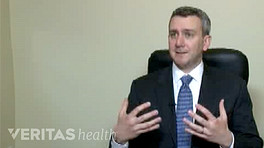Spinal discs play a crucial role in the lower back, serving as shock absorbers between the vertebrae, supporting the upper body, and allowing a wide range of movement in all directions.
If a disc herniates and leaks some of its inner material, though, the disc can quickly go from easing daily life to aggravating a nerve, triggering back pain and possibly pain and nerve symptoms down the leg.
See What's a Herniated Disc, Pinched Nerve, Bulging Disc...?
Disc herniation symptoms usually start for no apparent reason. Or they may occur when a person lifts something heavy and/or twists the lower back, motions that put added stress on the discs.
Lumbar herniated discs are a widespread medical problem, most often affecting people age 35 to 50.
This article covers how a lumbar herniated disc develops, how it is diagnosed, and the available surgical and non-surgical treatment options.
In This Article:
How a Lumbar Disc Herniates
A herniated disc occurs when the inner core of the disc bulges through the outer covering.
A tough outer ring called the annulus protects the gel-like interior of each disc, known as the nucleus pulposus.
Due to aging and general wear and tear, the discs lose some of the fluid that makes them pliable and spongy. As a result, the discs tend to become flatter and harder. This process—known as disc degeneration—starts fairly early in life, often showing up in imaging tests in early adulthood.
See The "Degenerative Cascade" of a Degenerating Disc
When pressure or stress is placed on the spine, the disc’s outer ring may bulge, crack, or tear. If this occurs in the lower back (the lumbar spine), the disc protrusion may push against the nearby spinal nerve root. Or the inflammatory material from the interior may irritate the nerve. The result is shooting pains into the buttock and down the leg.
A person with a herniated disc may be told by the doctor that degenerative disc disease led to the lumbar herniated disc. This term can be alarming and misleading. Degenerative disc disease is not a progressive disease per se, and it does not always cause chronic or persistent problems.
Lumbar Herniated Disc Symptoms Are Usually Short-Lived
The body works to shrink the herniated part of the disc and restore its natural shape.
While a lumbar herniated disc can be extremely painful, for most people the symptoms are not long-lasting.
Watch Video: Can Herniated Discs Heal on Their Own?
About 90% of people who experience a lumbar herniated disc will have no symptoms six weeks later, even if they have had no medical treatment. 1 Slipped Disk: Overview, National Library of Medicine, PubMed Health. Oct. 9, 2014. www.ncbi.nlm.nih.gov/pubmedhealth/PMH0072656/ .
Experts believe the symptoms from a lumbar herniated disc may resolve themselves for three reasons:
- The body attacks the herniation as a foreign material, shrinking the size of the herniated material and reducing the amount of inflammatory proteins near the nerve root.
- Over time, some of the water from inside the disc is absorbed into the body, causing the disc to shrink. The smaller disc is less likely to extend into nerve roots, causing irritation.
- Lumbar extension exercises may move the herniated area away from the spinal discs. Whether exercise can accomplish this is a matter of debate in the medical community.
In general, it is thought that the symptoms get better because the smaller size of the herniated material reduces the likelihood it will irritate the nerve root.
Although a lumbar herniated disc usually triggers attention when it becomes painful, medical research has found it is common for people to have a lumbar disc herniation in their lumbar spine, but no associated pain or other symptoms. 2 Brinjikji W, Luetmer PH, Comstock B, et al. Systematic Literature Review of Imaging Features of Spinal Degeneration in Asymptomatic Populations. AJNR American journal of neuroradiology. 2015;36(4):811-816. doi:10.3174/ajnr.A4173.
It is for this reason that care must be taken in the diagnosis to be sure a herniated lumbar disc is causing the problem.
Other Terms for Herniated Disc: Slipped Disc, Ruptured Disc
A herniated disc may compress the nearby nerve root, causing radicular pain.
A herniated disc may be referred to by many names, such as a slipped disc, or a ruptured or bulging disc. The term slipped disc can cause confusion since spinal discs are firmly attached to the vertebrae and do not slip or move—rather, it is just the gel-like inner material of the disc "slips" out of the inside.
Another common term for a herniated disc is a pinched nerve. This term describes the effect the herniated disc material has on a nearby nerve as it compresses or "pinches" that nerve.
A lumbar herniated disc may also be described in reference to its main symptoms, such as sciatica, which is caused by the leaked disc material affecting the large sciatic nerve. When a nerve root in the lower back that runs into the large sciatic nerve is irritated, pain and symptoms may radiate along the path of the sciatic nerve: down the back of the leg and into the foot and toes.
Sciatica may also be referred to by its main medical term, radiculopathy.
- 1 Slipped Disk: Overview, National Library of Medicine, PubMed Health. Oct. 9, 2014. www.ncbi.nlm.nih.gov/pubmedhealth/PMH0072656/ .
- 2 Brinjikji W, Luetmer PH, Comstock B, et al. Systematic Literature Review of Imaging Features of Spinal Degeneration in Asymptomatic Populations. AJNR American journal of neuroradiology. 2015;36(4):811-816. doi:10.3174/ajnr.A4173.














